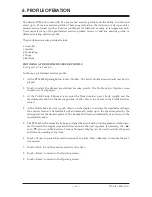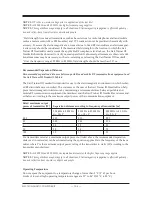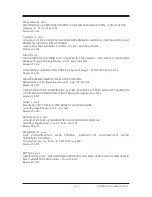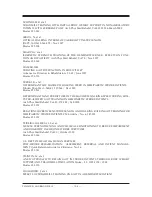
The need for tension adjustment is indicated by uneven belt speed or the belt stopping suddenly
upon foot impact. Properly tensioned, the treadbelt will allow the user to slip a hand snugly under
the center of the belt.
Treadbelt tension is adjusted by tightening or loosening the two hex-head, 9/16, bolts at the end of
the RTM 600 frame. The bolts should be adjusted in 1/4-turn increments, exactly the same amount,
in the same direction. Turn both bolts clockwise to tighten the belt. Turn both bolts counterclockwise
to loosen the belt. Failure to turn both bolts equally may affect tracking. One quick test is to apply
hand heel strikes and observe if belt momentarily stops. If belt speed remains constant, this indicates
belt is tight. If belt hesitates during heel strikes, additional tightening is required. To check over tight-
ening, set RTM 600 to .5 mph and, while holding rail, resist until belt stops. If drive roller continues
to rotate with the belt stopped, further adjustment is not necessary. If drive roller stops when belt is
stopped, belt is too tight. Loosen belt and recheck.
tracking
Tracking adjustment is necessary when a pronounced bump appears toward the left side of the
belt, approximately two inches from the left edge. This occurs when the belt works its way out of
the Exact-Track grooves.
To Adjust Treadbelt Tracking:
Tighten the hex tensioning bolt on the side to which the treadbelt has migrated, turn bolt in 1/8
increments clockwise. The tread belt should slowly move away from the tightened bolt. Once belt
migrates back into roller slot the bump will disappear. At this point, fine tracking adjustment is
necessary.
fine tracking
Fine tracking adjustment prevents premature wear of the tacking belt rib which rides in the Exact-
Track groove. The belt rib should be centered in the tracking groove. If the rib rides against the
groove wall, a friction point forms causing excessive wear. This adjustment should be made dur-
ing preventative maintenance or during belt replacements.
To Adjust Fine Tracking:
Determine which side of the exact track groove the belt rib is riding on. Mark treadbelt tracking
position on deck.
Tighten the hex tensioning bolt on the side the belt is tracking against, belt should migrate to the
opposite side of the groove. Mark the treadbelt tracking position on the deck. You now have two
marks on the deck 1/4” apart. Mark the center position of the marks. This is where the belt should
track. Adjust 9/16 tensioning bolt so that the belt is centered on the mark. Remember the belt will
migrate away from the tension bolt that is adjusted last. Tracking adjustments are done in forward
direction only, at 8 mph.
Check tensioning after adjustment to ensure proper belt performance and wear.
NOTE:
Motor drive belt should never slip. Check this when you check for treadbelt overtightening. If tread-
belt drive roller is stopped, motor should also stall. If motor turns, but drive roller is stopped, tighten motor
tension bracket located under the mill. Adjust until the motor belt stops slipping.
CONTENTS
— 8-5 —
MAINTENANCE
Summary of Contents for 950-284
Page 21: ......
Page 27: ......
Page 29: ......
Page 40: ...13 1 ASSEMBLY DRAWINGS AND SCHEMATICS 13 ASSEMBLY DRAWINGS AND SCHEMATICS...
Page 41: ...ASSEMBLY DRAWINGS AND SCHEMATICS 13 2 CONTENTS...
Page 42: ...13 3 ASSEMBLY DRAWINGS AND SCHEMATICS CONTENTS...
Page 43: ...ASSEMBLY DRAWINGS AND SCHEMATICS 13 4 CONTENTS...
Page 44: ...13 5 ASSEMBLY DRAWINGS AND SCHEMATICS CONTENTS...














































